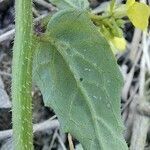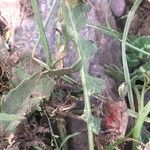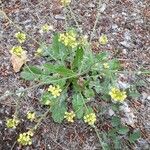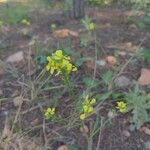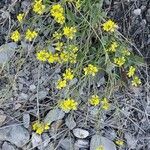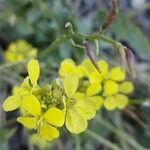Annual or over-wintering herbs up to 1 m high with ascending branches; lower part of stem densely retrorsely hairy. Basal leaves in a rosette, up to 20 cm long and 5 cm broad, lyrate-pinnatifid, somewhat runcinate, with 5-6 pairs of short, broad, lateral lobes and a large, oblong-ovate, obtuse, terminal lobe; all lobes ± dentate; densely white hairy. Lower stem leaves similar but smaller. Upper stem leaves small, sessile, simple, oblong to lanceolate. Sepals 3-4 mm long, narrow. Petals 6-8 mm long, spathulate, rounded. Siliquae 0.7-1.5 cm long, 1-1.5 mm in diameter, narrowly cylindrical, appressed-erect, on 2-4 mm long, erect pedicels almost as thick as the siliqua; valves 0.6-1 cm long, rounded, 3-nerved, veins obscure in ripe fruits; beak about 1/2 as long as the valves, 1-2-seeded, somewhat swollen. Seeds 76-152 mm each locule of the fruit, reddish-brown, c. 1 x 0-7 mm.
Stems (2-)4-15(-20) dm, densely pubescent proximally, trichomes retrorse. Basal leaves: petiole 1-4(-10) cm; blade (3-)4-22(-35) cm × 15-60 (-80) mm, lobes 1-6(-9) each side, ovate or lanceolate, (smaller than terminal), terminal lobe broadly ovate, surfaces densely pubescent. Cauline leaves (distal) ± sessile; blade oblong to lanceolate, similar to basal, (smaller distally). Fruiting pedicels (appressed to rachis, almost as thick as fruit), 2-4(-5) mm. Flowers: sepals 3-5 × 1.2-2 mm; petals 5-10 × 2.5-4.5 mm; filaments 3-5 mm; anthers 1-1.5 mm. Fruits 0.7-1.5(-1.7) cm × 1-1.7 mm; valves 6-10 mm; terminal segment 3-6 mm. Seeds 0.9-1.5 mm diam. 2n = 14.
Annual or biennial (occasionally perennial) herb to 1 m tall, erect, hirsute or scabrid. Lower leaves petiolate, lyrate-pinnatifid, the terminal lobe ovate, dentate; upper leaves reducing, sessile, simple, oblanceolate, dentate. lnflorescence a corymbose particle. Sepals 3–4 mm long, almost erect. Petals 6–8 mm long, yellow, often purple-veined. Siliqua 0.7–1.7 cm long, 1–1.5 mm wide, erect, pedicels thick, 2–4 mm long; beak 1-or 2-seeded, thick and swollen, 3–6 mm long; valves glabrous or hairy, 3-veined. Seeds 0.5–0.7 mm wide, red-brown, 3–6 per locule.
Annual herb, 0.5-1.0 m high, branches ascending. Stem: lower part retrorsely hairy. Leaves: basal leaves rosulate, lyrate-pinnatifid, somewhat runcinate, margins dentate, densely white-hairy, lateral lobes 5 or 6 pairs, short and broad, terminal lobes large, oblong-ovate, obtuse; lower cauline leaves similar but smaller, upper ones sessile, simple, small, oblong to lanceolate. Inflorescences a raceme. Sepals narrow. Petals spathulate, rounded, pale yellow. Fruit an appressed-erect siliqua, pedicellate, narrowly cylindrical. Seeds reddish brown.
A cabbage family herb. It is an annual plant. It can sometimes keep growing from year to year. It grows 1 m tall. The leaves are 4-22 cm long by 2-6 cm wide. The flowers are yellow. The seed pods are blunt. They are 7-15 mm long by 1-2 mm wide. They have small beaks each enclosing one seed. The seed is 0.9-1.5 mm across.
